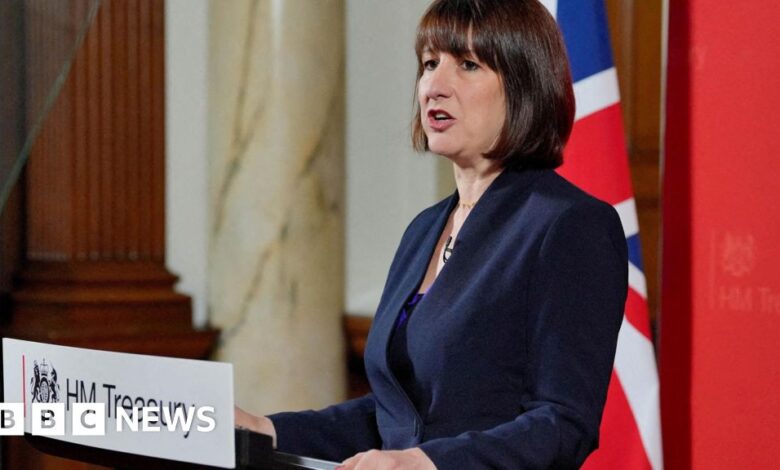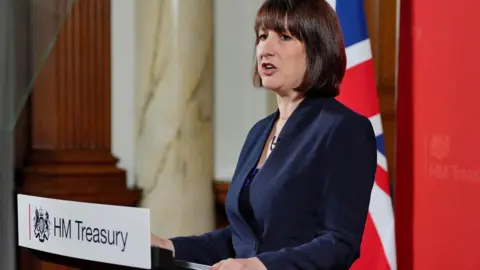What is Rachel Reeves’ plan for pension funds?

 Reuters
ReutersPlans for a major shake-up of pension funds have been announced by the chancellor, Rachel Reeves.
She wants to create pension “megafunds” by merging the UK’s 86 council schemes, using the set-up in Canada and Australia as a model.
Other proposals suggest pension schemes need to reach a certain size or pool together. Larger funds could then be invested in UK infrastructure projects, the government says.
So, will this affect people with pension savings?
Which pension funds are involved?
The government says the Local Government Pension Scheme (LGPS) can get more from investments – while tackling a £2bn bill for fees – by joining together.
There are 86 local government pension funds in England and Wales, which are mainly paid into by local government workers.
These individually managed funds are divided by local authority, making it more costly, because each fund is paying its own management and administration fees.
Between them, they have 6.5 million members and manage assets worth £354bn.
The schemes are all part of the LGPS which is the seventh-largest in the world, according to the UK government.
Most of its participants are low-paid women.
Under Reeves’ plans, the funds would be consolidated in some way, although at present it is unclear exactly how.
She may ask them to pool their assets and resources, or she may ask them to merge with one another to create a smaller number of larger funds, which would benefit from greater financial firepower and fewer costs.
The LGPS is a defined benefit scheme which means that, when it is time to draw their pensions, its savers get an agreed amount based on their salary, no matter what the fund is worth at the time.
So drawing scheme into “megafunds” will make little, or no, difference to what they receive.
That is different to private pension pots, which rise and fall in value depending on how investments perform.
Why copy Canada and Australia?
The “Maple 8” is a group of vast Canadian pension funds, including the Ontario Teachers’ Pension Plan, which manages assets worth C$247.5bn (£141.8bn), and the Canada Pension Plan, whose assets are worth C$409.6bn.
While UK pension schemes tend to invest more in assets like equities and bonds, their Canadian rivals focus more on private markets.
The Ontario Teachers’ Pension Plan, for example, only has 7% of its assets in listed equities, compared with 60% for traditional pension funds.
Instead, it skews its investments towards private markets, including infrastructure (including a 25% stake in British energy giant SSE), real estate and private equity deals.
This kind of model is not without risk, however.
The Ontario Municipal Employees Retirement System is the largest investor in the troubled Thames Water, which has been highlighted by those questioning Reeves’ plans.
Why is bigger supposed to be better?
Individually, the UK’s 86 local government pension schemes vary in size, from Greater Manchester’s massive £30bn fund all the way down to several schemes which are “sub-£1bn”, according to Joanne Donnelly, board secretary at the Local Government Pension Scheme Advisory Board.
Running these schemes costs money. Each one must pay administration, governance and management costs, which can build up – last year, they increased by £28m.
Like her predecessor, Jeremy Hunt, who also announced plans for a Canadian-style model, the chancellor believes consolidation would save money.
That would in turn “deliver better returns for savers and unlock billions of pounds of investment”.
Other chancellors have aimed to make similar moves, including George Osborne who, in 2015, set out plans for local government schemes to pool resources,
Does everyone agree with the idea?
Tracy Blackwell, chief executive of Pension Insurance Corporation, told the BBC: “I think by having the scale and the right expertise internally to invest in a wide range of assets, they’ll be able to invest in a lot more than what they can invest in now.”
However, some argue megafunds would not invest so much in smaller projects while some claim the changes could bring risks for pension savers.
“Conflating a government goal of driving investment in the UK and people’s retirement outcomes brings a danger because the risks are all taken with members’ money,” said Tom Selby at investment platform AJ Bell.
He said the current system encourages trustees to deliver the best outcome for members rather than focus on UK-wide economic growth, which might mean investing outside the UK.
Others question whether there are enough big UK projects to invest in.
“Large funds need substantial, reliable projects to generate returns, but the market may struggle to offer enough of these opportunities, especially in the infrastructure sector,” said Jon Greer, head of retirement policy at wealth manager Quilter.




